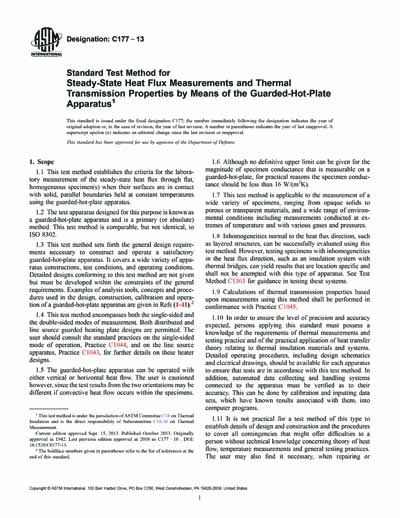Historical
ASTM C177-13
Standard Test Method for Steady-State Heat Flux Measurements and Thermal Transmission Properties by Means of the Guarded-Hot-Plate Apparatus
1.1 This test method establishes the criteria for the laboratory measurement of the steady-state heat flux through flat, homogeneous specimen(s) when their surfaces are in contact with solid, parallel boundaries held at constant temperatures using the guarded-hot-plate apparatus.
1.2 The test apparatus designed for this purpose is known as a guarded-hot-plate apparatus and is a primary (or absolute) method. This test method is comparable, but not identical, to ISO 8302.
1.3 This test method sets forth the general design requirements necessary to construct and operate a satisfactory guarded-hot-plate apparatus. It covers a wide variety of apparatus constructions, test conditions, and operating conditions. Detailed designs conforming to this test method are not given but must be developed within the constraints of the general requirements. Examples of analysis tools, concepts and procedures used in the design, construction, calibration and operation of a guarded-hot-plate apparatus are given in Refs (1-41).2
1.4 This test method encompasses both the single-sided and the double-sided modes of measurement. Both distributed and line source guarded heating plate designs are permitted. The user should consult the standard practices on the single-sided mode of operation, Practice C1044, and on the line source apparatus, Practice C1043, for further details on these heater designs.
1.5 The guarded-hot-plate apparatus can be operated with either vertical or horizontal heat flow. The user is cautioned however, since the test results from the two orientations may be different if convective heat flow occurs within the specimens.
1.6 Although no definitive upper limit can be given for the magnitude of specimen conductance that is measurable on a guarded-hot-plate, for practical reasons the specimen conductance should be less than 16 W/(m 2K).
1.7 This test method is applicable to the measurement of a wide variety of specimens, ranging from opaque solids to porous or transparent materials, and a wide range of environmental conditions including measurements conducted at extremes of temperature and with various gases and pressures.
1.8 Inhomogeneities normal to the heat flux direction, such as layered structures, can be successfully evaluated using this test method. However, testing specimens with inhomogeneities in the heat flux direction, such as an insulation system with thermal bridges, can yield results that are location specific and shall not be attempted with this type of apparatus. See Test Method C1363 for guidance in testing these systems.
1.9 Calculations of thermal transmission properties based upon measurements using this method shall be performed in conformance with Practice C1045.
1.10 In order to ensure the level of precision and accuracy expected, persons applying this standard must possess a knowledge of the requirements of thermal measurements and testing practice and of the practical application of heat transfer theory relating to thermal insulation materials and systems. Detailed operating procedures, including design schematics and electrical drawings, should be available for each apparatus to ensure that tests are in accordance with this test method. In addition, automated data collecting and handling systems connected to the apparatus must be verified as to their accuracy. This can be done by calibration and inputting data sets, which have known results associated with them, into computer programs.
ASTM International [astm]

